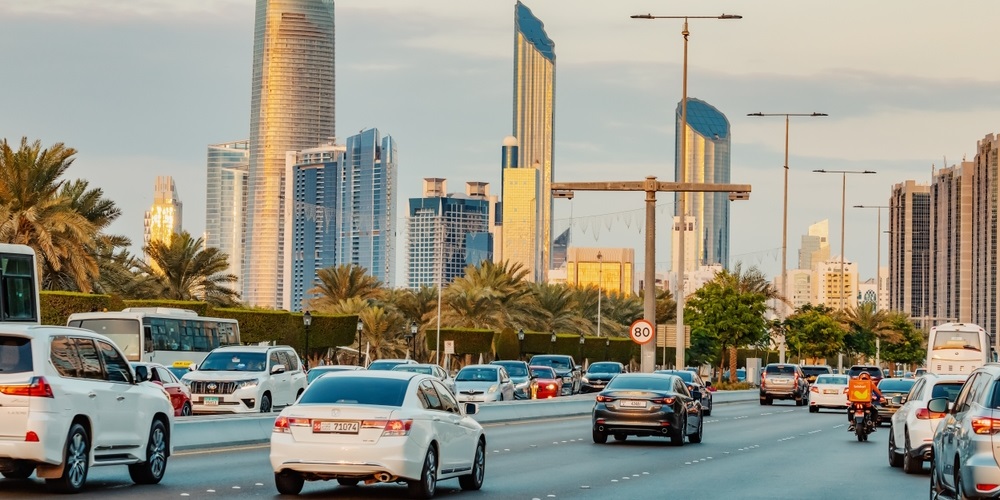Safety and traffic flow remain first concerns as the United Arab Emirates (UAE) is modernising and extending its infrastructure—especially in big cities like Abu Dhabi and Dubai. Abu Dhabi has adopted new rules on big vehicles in 2025, which are already changing road usage across the city. Particularly at busy times, these guidelines seek to improve traffic efficiency, lower congestion, and raise safety. Although these developments mostly target commercial transportation companies, visitors planning road excursions or city navigation by rented automobiles should also pay attention.
Knowing Abu Dhabi’s new heavy vehicle laws in 2025 is crucial whether your trip is returning or first-time and you are renting a car or using the UAE’s highways. This book will enable you to understand what is changing, how it could influence your trip, and what visitors should be aware of throughout their stay.
Overview of the Heavy Vehicle Restraints for 2025
The Department of Municipalities and Transport (DMT) of Abu Dhabi has adopted new rules for 2025 controlling the flow of heavy vehicles like trucks and trailers. These steps are meant to increase traffic flow, particularly during rush hours, and apply to some routes at designated times frames.
Usually between 6:30 a.m. and 9:00 a.m. and 3:00 p.m. to 6:00 p.m., heavy vehicles are now limited from entering important arterial highways during peak travel hours. Among others, roads impacted are Sheikh Zayed Road, Corniche Road, and the E22 (Abu Dhabi–Al Ain Road). Although the rules target cars above 2.5 tonnes, changes in traffic signal priorities and dispersion of traffic mean that their influence might be felt by regular travellers.
Why Exactly the Changes Were Made
The new heavy vehicle regulations result from several important issues. Urban expansion and fast population increase have caused traffic congestion on Abu Dhabi’s roads to rise. The authorities have responded with new timing limitations on heavy vehicles, road network upgrades, and smart traffic management systems implementation.
These adjustments also aim to lower traffic accidents. Larger cars are more likely, especially in high-density traffic, to be involved in major traffic events according to studies. City designers seek to increase general road safety by controlling when and where these vehicles may operate.
How the Rules Affect Rental Drivers and Travellers
Although visitors are unlikely to be operating large trucks or cargo vehicles, the new rules could have indirect consequences. For a road journey between Abu Dhabi and Dubai or a picturesque drive down the coast, for instance, you could run across delays on other roads now utilised by diverted goods traffic. Additionally, some hotels and attractions close to busy freight routes could suffer more congestion at off-peak times.
Drivers of rented cars might have to change their plans to evade the worst of the rerouted traffic. Keep your app current and check live traffic conditions as navigation apps like Google Maps and Waze have begun included the new limits into their route suggestions.
Read Also :Dubai: 3 New 24/7 Beaches Now Open; Night Swimming Allowed
Working with other Emirates
Abu Dhabi’s new heavy truck rules fit more general initiatives throughout the UAE aimed at simplifying goods flow. Actually, by restricting truck traffic at comparable timesframes in Dubai and other surrounding emirates, the Dubai Emirates road truck ban 2025 complements Abu Dhabi’s actions. This cooperation guarantees better intercity mobility and lowers the possibility of congestion where emirates converge.
If your travel plans call for driving between Abu Dhabi and Dubai, especially by Emirates Road (E611), be ready for different speed restrictions, possible detours, and more traffic on bypass routes as a visitor. If at all possible, avoid driving during restricted hours to guarantee a better ride.
Advice for negotiating Abu Dhabi’s 2025 road map
With enough understanding and forethought, visitors can still have hassle-free travel. Under the new heavy vehicle regulations, bear these points in mind while you negotiate Abu Dhabi:
Travel outside of peak hours.
Plan your driving outside of the morning and evening rush hours when the limitations’ most obvious effects are seen.
Make use of real-time navigation.
Use real-time GPS apps to assist in rerouting you should traffic cause arise. Check to see if your phone has a local data plan or use a SIM card from a UAE provider.
See for New Road Signs:
Many of Abu Dhabi’s road signage now reflect the revised rules. Look at signs alerting you to new lanes, truck limits, or road priorities changing.
Steer clear of industrial routes since directed truck traffic could rise in these zones. Steer clear of these regions on your way to see tourist sites.
Think about public transit; Abu Dhabi boasts a sleek and expanding bus and taxi fleet that will allow you completely escape traffic.
End Note
The 2025 heavy vehicle regulations of Abu Dhabi are a component of a broader comprehensive vision aiming at ensuring safer, smarter, more efficient roadways for the city. Although these adjustments mostly target lessening of commercial traffic congestion, they affect all road users, including visitors. Understanding the new system and making appropriate plans will help guests to guarantee a stress-free travel experience and enjoyment of all the UAE has to offer.
From seeing the magnificent Sheikh Zayed Grand Mosque to driving down the picturesque Corniche, Abu Dhabi provides amazing travel experiences—and with some traffic smarting, you can maximise your trip in this always changing city.
Author Bio
Travel writer and road safety consultant Liam Carter specialises on the Middle East. He clarifies for overseas guests the regional transportation modifications for better travels. Liam works with PeaceLandTravel Dubai, UAE to offer current travel advice on the UAE and beyond.


